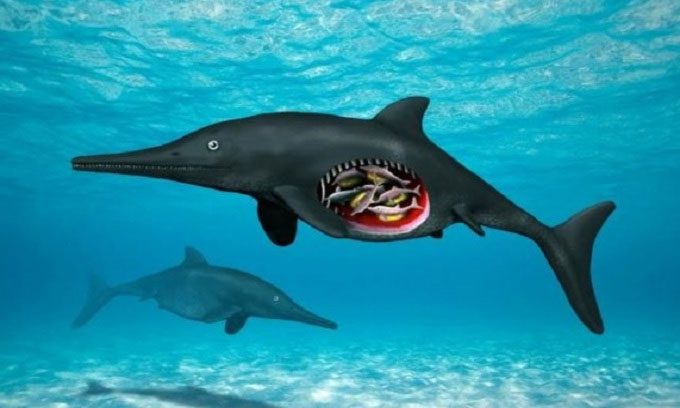A research team excavates a 4-meter-long skeleton of a pregnant ichthyosaur found on the Tyndall Glacier.
The fossil of the ichthyosaur, named Fiona by researchers from the University of Manchester, UK, was unearthed from a melting glacier in Patagonia. Fiona was pregnant when it died 139 million years ago, with several embryos still in its womb.

Reconstructed image of the pregnant ichthyosaur. (Photo: N. Tamura)
“The ichthyosaur fossil is remarkably well-preserved in such extreme conditions, revealed by the retreating glacier, which is an unprecedented discovery anywhere else in the world. The large number of ichthyosaur fossils found in the area, including complete skeletons of mature, juvenile, and young specimens, will provide a unique insight into the past,” said Dr. Dean Lomax, a paleontologist involved in the project.
Ichthyosaurs were marine mammals that lived during the age of dinosaurs, known for their fish-like bodies, similar to modern-day dolphins. Fiona’s fossil was discovered during an expedition to the Tyndall Glacier in March and April 2022. The research team had to climb for 10 hours or ride horses to reach this glacier, making specimen collection particularly challenging.
This is the only recorded pregnant ichthyosaur excavated from the early Valanginian-Hauterivian of the Cretaceous period (129 – 139 million years ago). With a length of 4 meters and several young in its womb, the fossil will provide extensive information about the species, such as the biological characteristics of embryonic development or diseases that may have affected Fiona. In addition to Fiona, the researchers also found 23 other new specimens during the expedition, turning the Tyndall Glacier into the world’s richest fossil site for ichthyosaurs.
To excavate Fiona, Lomax and his colleagues constructed a shelter above the site to protect against strong winds, rain, and snow. They also required specialized equipment to dig through the hard rock layer. The rock at the edge was so hard that it could not be excavated with hammers and chisels. The research team had to cut, drill, and break each rock block using diamond tools and other equipment.
After excavating Fiona’s fossil, they transported the skeleton from the Tyndall Glacier to the Rio Seco Natural History Museum in Punta Arenas, located 400 km away. They will prepare to study the fossil in the paleontology laboratory at the museum. The research team hopes to compare the ichthyosaurs from the Tyndall Glacier with many skeletons previously discovered in Europe.




















































